In a tank, sitting in the windowsill in our bedroom are creatures -- some of which we hope haven't hatched yet, and hopefully are not hatchable due to our "conditions". Instead of raising our intended animal, we instead have . . . one of these (we have no idea what happened to the others, which mysteriously disappeared one day):

A lot of these:

And none of these, our supposed creature we were supposed to raise from the kit bopitybop received for Christmas:

You might be thinking, "Man, what a rip-off -- you only have a sea monkey and some weird floaty things." Well, we knew they would come beforehand. We did some research when we got the box on how to raise the triops (the third picture), as they are called; apparently the poster, which was included, had very vague instructions on care-taking.
However, after doing extensive research of info lumped together, we found many facts about these "triops".
- T. longicaudotus is the most common sold in stores, the ones we bought.
- They can eat bits of raw meat and parboiled (boiled for five minutes) vegetables.
- They are cannibals; the bigger triops eat the smaller ones of their kind in some cases.
- They have three eyes, one which senses direction, and the other two which keep a watch on food and predators.
- They breathe through their legs; their gills are attached there.
These are just some of the facts we collected during our researching spree.
Triops have been around for over 220 million years, dubbed "living fossils", ever since Pangaea (the super-continent) broke apart. They have a very different way of living compared to other aquatic animals -- they reside in pools of water just about everywhere, which is why they have such a short lifespan, and they have a hatching system where all the eggs won't hatch at once. Once these eggs dry, they become dormant, hence why they are available at stores. Of course, when you rehydrate them, at the right conditions, they will hatch in less than two days, on average. To raise them is actually similar to the so-called "sea monkeys" way of care-taking.
Ours didn't hatch, probably because we didn't have a "light source" to heat them up to the right temperature. Instead, we got the hardy creatures -- the fairy shrimp (the first picture) and the daphnia, or water fleas (second picture). We found out their eggs are already inside the packets of triops eggs to provide a "food source' for them, since triops will practically eat everything they are given, even the common housefly.
The kit came with a hatching nutrient called detritus, which are dried plant pieces. Detritus is meant to mimic their natural habitat and is mixed with the triop eggs. The kit also came with food pellets that we were supposed to crush at first and feed (which was impossible until Karen8899 realized they were slightly moldable), then later, when they got bigger, to feed whole. Clearly, we never did get to.
Bopitybop's kit was purchased at Michael's, the art store. You might've seen the medium-sized box featuring "Prehistoric Sea-Monsters" and a bunch of horseshoe crab-like things swimming around in a enlarged tank. In reality, the tank is quite small, the length a little less than an iPad, and there aren't triops flitting around in their habitat at first sight, obviously. The sand isn't actually that horizontally perfect either. The description, however, might be easily recognizable, and maybe you'll find it, if it's still in stock, and try to raise them.
That is, if you're interested . . .
karen8899 and bopitybop
Author's Note: Pictures from http://www.arkive.org/fairy-shrimp/chirocephalus-diaphanus/image-A7971.html, http://www.google.com/imgres?imgurl=http://cfb.unh.edu/cfbkey/html/Organisms/CCladocera/FDaphnidae/GDaphnia/Daphnia_rosea/Daphnia_rosea1large.jpg&imgrefurl=http://cfb.unh.edu/cfbkey/html/Organisms/CCladocera/FDaphnidae/GDaphnia/Daphnia_rosea/daphniarosea.html&usg=__-KiTp9AHpGL_1SdMoGMmoqvXGMY=&h=360&w=360&sz=35&hl=en&start=24&zoom=1&tbnid=syKy9PNs7AcfvM:&a mp;tbnh=121&tbnw=121&ei=9v0IT5zlKIOFiAKl7uD-DQ&prev=/images%3Fq%3Ddaphnia%26start%3D21%26hl%3Den%26sa%3DN%26rlz%3D1T4ADFA_enUS375US376%26tbm%3Disch&itbs=1, and http://www.triopsguys.com/species/triops-longicaudatus/. Information from
http://mytriops.com/articles/faq1.stm.